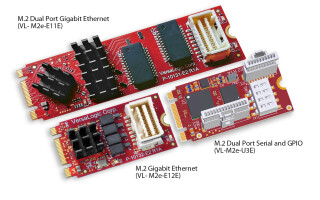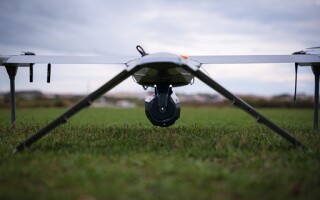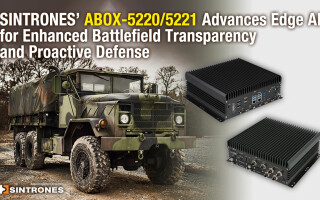Expanding options in VPX connectivity
StoryOctober 12, 2011
VPX embedded systems require robust interconnections to achieve and maintain signal integrity. Commercial technology is being ruggedized and adapted for use in power (VITA 62), optical (VITA 66), and RF (VITA 67) applications to supplement the qualified digital backplane connectors and complete the high-performance architecture?s interconnect technology set.
Manufacturers of embedded systems for military and aerospace uses face the daunting challenge of maintaining pace with the rapidly evolving world of electronic systems. There is an ongoing migration toward serial switched architectures that support high-speed protocols, such as 10 Gbps Ethernet, to realize advantages such as eliminating differential skew in parallel data paths. While commercial silicon continues driving bandwidth and processing power, embedded computing platforms in the high-reliability world of military/aerospace applications require rugged technologies capable of withstanding vibration, thermal extremes, and other application rigors.
Modern embedded computing systems depend enormously on board-level interconnects to support mission- and life-critical applications. VITA is a primary source for standardized embedded architecture development in aerospace and defense. VITA has guided the progress from the original VMEbus to the latest standards, such as VITA 41 (VXS) and VITA 46 (VPX) systems. VXS provides a transition between traditional VMEbus parallel architectures and newer serial switched architectures. VXS uses both the traditional VME connector and a selection of modules from the newer MULTIGIG RT connector family. Unlike VXS, the serial VPX does not straddle both the parallel and serial worlds.
One drawback to VPX was interoperability issues. First, VPX allows a wide range of configuration options, many of which are never used. Second, the standard VPX connector is designed primarily for digital signals. This left designers fashioning ad hoc technologies for power, optical, and RF connectivity, which only made interoperability issues worse.
To assure interoperability on an architectural level, VITA 65 (OpenVPX) has been established as the governing standard and defines profiles for various configurations at the chassis, backplane, slot, and module levels. The ultimate goal is to create compatibility between products from different vendors, enabling open architecture and also two-level maintenance and system upgrades, allowing users to swap out Line Replaceable Modules (LRMs) in the field. To remedy the deficiencies in the interconnect technologies, a new series of standards has evolved, including VITA 62 (power), 66 (optical), and 67 (RF).
Adapting COTS connectivity for the militarized zone
Commercial connector technology is at the forefront of supporting multigigabit data rates. Designing a high-speed connector is a challenge in electrical engineering. (High speed is a slippery term in relation to connectors: Essentially, the concept of high speed comes into play when electrical modeling treats the signal path through the connector as a transmission line, with the effects of impedance, capacitance, and inductance all critically affecting signal integrity. In some respects, the size of any impedance discontinuity compared to the signal rise time determines the difference between a “regular” connector and a high-speed connector.) High-speed connectors typically represent the largest impedance discontinuity in the signal path. Their design requires a delicate balance of conductor and dielectric to prevent reflections, crosstalk, and other forms of signal degradation. High-speed commercial connectors can meet demanding electrical requirements, but struggle to meet the mechanical ruggedness of military/aerospace requirements.
Conversely, traditional military/aerospace connectors are rugged, but don’t offer the speed and density required. The latest rugged connector designs blend the best attributes of high-speed commercial connectors with lessons learned from military/aerospace applications, offering the optimal combination of gigabit data rates, dense packaging, and mechanical robustness. Even though commercial backplane connectors are not directly usable in military/aerospace applications, it is much easier to take the proven signal-transmission technologies and incorporate them into a more robust package than it is to build a new connector from the ground up. The goal, then, is to take the best of COTS technology and ruggedize it.
This goal was realized in establishing the VITA 46 digital interconnect for VPX and represents a well-executed process of ruggedization and validation. Table 1 compares a number of environmental performance tests of the source commercial connector and the ruggedized VPX version to illustrate the extended validation testing performed. Note that the VPX connector must pass additional tests that the commercial version does not.
Table 1: Ruggedized VITA 46 connector performance versus its commercial counterpart
(Click graphic to zoom by 1.9x)
The connector’s plug-in module wafer design in place of pin contacts is well established in commercial applications. Wafers – available for differential, single-ended, and power needs – can be easily modified to support specific customer needs for characteristic impedance, propagation delay, and other electrical parameters. The pinless backplane half of the connector assures protection of the motherboard, thereby protecting the system, vehicle, and mission. Signal integrity has been elevated in parallel with the mechanical integrity. As a ruggedized version of a commercial design, the VPX connector supports speeds up to 10 Gbps, well above that need to support VPX’s 6.25 Gbps. The design is highly modular to support both 3U and 6U configurations.
VITA 62: High-density power
While power can be brought through the VPX connector, a higher-capacity route is offered by VITA 62 (Power Supply Modules), which refines VITA 46 power requirements to support OpenVPX system-level requirements and to address such issues as in-rush current at power-up, output control, and synchronization. The connectors defined in VITA 62 are focused on the power-handling task. The dedicated power contacts, derived from commercial designs, deliver up to 40 percent more power in the same space over earlier generations of contacts. With both 20 A and 50 A contacts, the design is hot pluggable, tolerates mating misalignment, and has lower mating forces.
VITA 66: Enlightened optical connectivity
VITA 66 [Fiber Optic Interconnect (Formerly 46.12)] further expands the VPX ecosystem by defining optical modules that demonstrate the advantages of using proven, existing technology and adapting it to new applications. Providing separate modules for optics (or RF) assists design and manufacturing by allowing Line Replaceable Units (LRUs) and LRMs to be disconnected at the backplane, which greatly speeds assembly, maintenance, and upgrades. Older approaches worked similarly, but the new modular approach fits the VPX form factor, is scalable, and creates an industry-standard methodology in place of ad hoc approaches.
VITA 66 gives users the choice of MT array connectors, ARINC 801 termini, or Expanded Beam (EB) contacts using a common module form factor (Figure 1). Each of these has an aerospace pedigree and offers different benefits in terms of density, ruggedness, reparability, and other characteristics. For example, the MT ferrule offers the highest density of fibers –up to 48 in a 3U system and 240 in a 6U system. The ARINC 801 contact, based in the established 2.5 mm ceramic ferrule, offers the best optical performance with low insertion loss and low reflectivity. The expanded-beam connector is the most forgiving of dirt, vibration, and frequent mating and unmating. Any of the optical connectors are contained in a robust machined housing that includes guides and keying. Modules can be used in positions P2/J2 through P6/J6.
Figure 1: VPX system with VITA 46 and VITA 66 modules
(Click graphic to zoom by 1.9x)
VITA 67: High-density RF to 40 GHz
VITA 67 (Coaxial Interconnect on VPX) covers RF connectivity and is based on blindmate SMPM contacts, which allow high performance to 40 GHz in a high-density configuration. Conforming to the same envelope as the VITA 66 fiber optic modules, the RF modules support four or eight positions, are also scalable, and allow very rapid assembly, repair, and reconfiguration of the open architecture VPX systems.
Ruggedized commercial products meet military needs
Adapting and evolving commercial interconnection technology has proven to be the preferred way to meet the ever-increasing needs of military embedded computing. Commercial technology often leads in achieving new levels of speed and density, needing only to be sufficiently ruggedized to meet the stricter requirements of high-reliability applications. While such ruggedization of commercial technology might not be a trivial matter, it often provides a lower risk and faster path to market than starting from scratch. Rather than proving a technology works at all, it only needs to be demonstrated that the technology – already widely used – works in a more rigorous environment.
Gregory Powers serves as Market Development Manager for the Electronic Systems and Space segments within the Global Aerospace, Defense & Marine business unit of TE Connectivity. He received a BSME from Syracuse University, has completed numerous graduate-level studies, and holds two patents relative to optical datacom devices. He can be contacted at gregory.powers@te.com.
TE Connectivity 425-413-1910 www.te.com








